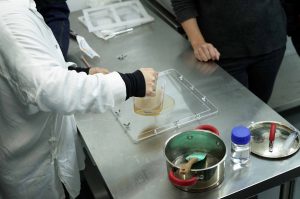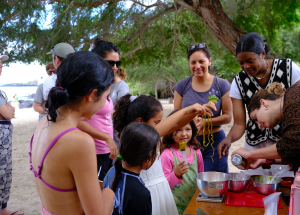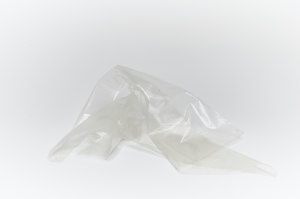 Log In
Log In
The Principles of Green Chemistry are designed to help chemists make safe and sustainable choices for human and environmental health. Green chemistry can be defined as the design of chemical products and processes that reduce or eliminate the use and generation of hazardous substances. Today, companies, governments, and higher education systems are integrating them into curricula and practice. Dr. Charlene Smith, Green Chemistry Lead at Materiom, shares her views on the role of green chemistry in regenerative biomaterials innovation.
CS: Yes, absolutely. I have a PhD in inorganic chemistry focused on single-molecule magnets and nanotechnology, which is very small-scale chemistry for the innovation of smart materials. I then transposed this expertise to prioritise green chemistry practices through regenerative research and development using biopolymers, looking at materials that work with the earth’s natural ecology.
At Materiom, I implement green chemistry practices in the development of novel, compostable biomaterials, fine tuning their properties based on their intended application or functionality – for instance, formulating hard, soft or flexible composite materials. These provide businesses, entrepreneurs, startups, and green chemistry practitioners examples that guide green chemistry biomaterial making from the beginning of their practice.

Dr. Charlene Smith speaking at biOrbic research conference in Ireland, 2022
CS: For me the trigger was fully understanding the impact of the materials I was initially using to create smart applications: the exhaustive use of solvents – harsh acids and bases – where the yields are very, very small, but the formulation process still requires extraction through large amounts of toxic or corrosive materials. This started to have an effect on me in the sense that I would ask myself, “if I’m just one chemist in a lab, and this is going on all over the world, from desk research, to manufacturing, to large-scale factories, how much of this is being emitted into our atmosphere and our environments?”
That notion prompted me to explore green chemistry practices that don’t necessarily require the exhaustive use of heat or pressure, or acute corrosive chemicals. We only have one planet and we are living in a world of accelerated innovation. Why do we have to resort to toxic, fossil-fuel-based materials when we can work alongside nature, rather than against it? It sounds so simple, but nature has been evolving for billions of years; it’s managed to withstand what we’ve thrown at it, it’s evolved, it’s created new capabilities and capacities to survive. Nature’s innovation process is incredibly sophisticated, so why don’t we use it as a guide for making high-performance materials?
CS: What we aim to do at Materiom – and in my role as a green chemist – is look at materials from the beginning of the design process, right through to the end of life. At the beginning, we look at what potential impact a material will have on a particular localised ecosystem – each component of the material system has to be considered, whether that’s the volume, location and method in which biomass is sourced; or the solvent used (in green chemistry, water is a predominant solvent); or how that solvent interacts with other ingredients used. We also look carefully at how materials will break down at the end of life: can they be re-used to make new materials? Or can their nutrient value be recovered and used as compost to support our soils?
Processes, including low pressure, low heat, and solvent use are key for green chemists – not only looking at the material components, but also the methods and energy used in development. Key research questions we ask ourselves, particularly with the scale-up aspect of material development, are: if a particular solvent is being used and it’s not water, how can that solvent be recaptured in a closed-loop system? By using green chemistry can we minimise the negative effects of that material on the environment?
As a chemist, it’s quite easy to get lost in the conventional, pragmatic – quite analytical – way of thinking. What green chemistry has taught me is to be more intuitive with approaches to material making. We place value on how to adapt our methods to account for the systemic aspects of material making – not just the end product and any associated aesthetics, but how these materials would work symbiotically with the local environment around us.

FONDEF Bioplastic Territorial Chile workshop analysing the value chain of algae-based bioplastics.
CS: Last year, in partnership with the University of Exeter and the Galapagos Conservation Fund, we identified key organic waste streams on the Galapagos Islands, namely shellfish, alongside various agricultural byproducts, including some invasive species of biomass. We were then able to create materials that were 100% biobased and 100% biodegradable, running analysis on how these materials could encourage local ecosystems to thrive at the end of life in the form of compost and soil amendment. We worked with local artisans to identify the materials they currently used and how these bio-based alternatives could be incorporated into their process.
The goal of the project was to plot a circular materials value chain: transforming waste from fisheries into biodegradable materials that can be used by artisans to produce products that can compost at the end of life to support farmers and soils. From the exoskeleton of shellfish waste we can extract a material called Chitosan, derived from Chitin, and that material has so many diverse functionalities: it can be a flexible biofilm, but it can also be a robust, solid, casted material. It is produced in large tonnage on the island and deemed as waste, but it can actually be used as a diverse material source for products used by the tourism industry, whether that’s biofilms for packaging or waste disposal bags. It was great to work alongside the community to understand their needs based on their organic waste streams in addition to what would be beneficial for different groups of people in the community and their value chains.
This kind of holistic field work works well alongside the more technical material development work we do. When we returned to the UK, we began to investigate how different composite materials, made up of varying biopolymers, can be used to create different applications. Multiple biopolymers can be derived from the same waste streams, each with its own set of properties. So we began to vary the concentrations of each biopolymer and introduced additional ingredients to help fine-tune the performance properties of the material composites in order to create the next-generation of bio-based products.

Materiom workshop with local Galapagos communities – promoting awareness of biomaterial development
CS: We have been locked into using petrochemical materials for so long. There is a misconception that these are the most advantageous or the highest performing materials that can be discovered. But we can create high-performing materials using biopolymers from renewable sources. Spider silk is pound for pound stronger than steel. We need to challenge misconceptions about how biomaterials can perform against fossil fuel-derived materials, which is difficult when it may serve to undo many of the business models larger multinationals have designed.
Another challenge is shifting mindsets around how materials are specified for certain applications. Most everyday packaging products, condiment packaging for example, do not need to last for hundreds of years – we only need them to last a matter of days. So, if we can create, for example, biofilms to encase these products that can then biodegrade to provide nutrients to soil and marine environments, it seems like a no brainer. It’s actually working symbiotically, serving our needs as consumers, and those of our local natural ecological systems. Once we start to change perceptions around this, then producers, manufacturers, industry, and policymakers will give more attention and funding to biomaterial development as a primary focus.
Another challenge is scale up. It’s one thing being in a wet lab or a prototyping lab (which of course is essential and necessary for initial development), but when we’re talking about understanding how a material performs on a mass-produced scale, it can sometimes operate differently. For example, when things work well with water at a prototyping stage, we may need to look at other green solvents that are more suited to scale-up.

Agar bioplastic, featured on the Materiom Commons material database. Agar agar is a plant-based gelatin derived from seaweed.
CS: This research paper was primarily a toxicology and environmental impact study on a series of bioplastic films made from gelatin, chitin, and seaweed-based biopolymers, to see how they interact with different environments when they break down. It was done in collaboration with the University of Exeter, and the findings revealed that because these biomaterials have considerably low persistent and low acute toxicity, they can be deemed environmentally safe. In terms of ecotoxicology, they do not emit any disruptive elements to biodiversity. Which essentially opens up the potential for these particular materials to be used in a diverse range of applications as alternatives to petrochemical materials. The next step would be to look at the additive nutrient potential of these materials, but this first step was to verify that they are non-toxic and safe to use environmentally.
CS:
Are you working in or interested in this field? To learn more about Materiom’s green chemistry practices or discuss potential collaboration trajectories, drop us a note on: [email protected]
*An abridged version of this article was first published on Packaging Europe on 30 August 2023.